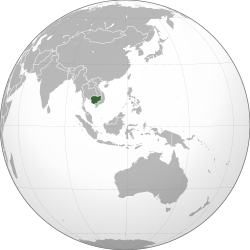Khmer Republic
| Khmer Republic | ||||||||||
|
សាធារណរដ្ឋខ្មែរ Sathéaranakrâth Khmer |
||||||||||
|
||||||||||
|
||||||||||
|
Motto សេរីភាពសមភាពភាតរភាពវឌ្ឍនភាពនិងសុភមង្គល "Liberty, Equality, Fraternity, Progress and Happiness" |
||||||||||
|
Anthem បទចំរៀងនៃសាធារណរដ្ឋខ្មែរ Anthem of the Khmer Republic |
||||||||||
| Capital | Phnom Penh | |||||||||
| Languages |
Khmer (official) French |
|||||||||
| Religion | Buddhism | |||||||||
| Government | Unitary presidential constitutional republic under military dictatorship | |||||||||
| President | ||||||||||
| • | 1970–1972 | Cheng Heng | ||||||||
| • | 1972–1975 | Lon Nol | ||||||||
| • | 1975 | Peter Khoy Saukam (acting) | ||||||||
| Prime Minister | ||||||||||
| • | 1970–1971 | Lon Nol | ||||||||
| • | 1971–1972 | Sisowath Sirik Matak | ||||||||
| • | 1972 | Son Ngoc Thanh | ||||||||
| • | 1972–1973 | Hang Thun Hak | ||||||||
| • | 1973 | In Tam | ||||||||
| • | 1973–1975 | Long Boret | ||||||||
| Legislature | Parliament | |||||||||
| Historical era | Cold War | |||||||||
| • | Coup d'état | 18 March 1970 | ||||||||
| • | Republic proclaimed | 9 October 1970 | ||||||||
| • | Fall of Phnom Penh | 17 April 1975 | ||||||||
| Area | 181,035 km² (69,898 sq mi) | |||||||||
| Population | ||||||||||
| • | 1975 est. | 7,952,000-8,102,000 | ||||||||
| Currency | Cambodian riel | |||||||||
|
||||||||||
| Today part of |
|
|||||||||
The Khmer Republic (Khmer: សាធារណរដ្ឋខ្មែរ); also known as the State of Cambodia was the right-wing pro–United States military-led republican government of Cambodia that was formally declared on 9 October 1970. Politically, the Khmer Republic was headed by General Lon Nol and Prince Sisowath Sirik Matak that took power in the 18 March 1970 coup against Prince Norodom Sihanouk, then the country's head of state.
The main causes of the coup were Norodom Sihanouk's toleration of North Vietnamese activity within Cambodia's borders, allowing heavily armed Vietnamese Communist outfits de facto control over vast areas of eastern Cambodia. Another important factor was the dire state of the Cambodian economy, an indirect result of Sihanouk's policies of pursuing neutrality.
With the removal of Sihanouk, the existing Kingdom of Cambodia became a republic, although the throne had been officially vacant for some years since the death of King Norodom Suramarit. The character of the new regime was right-wing and nationalist; most significantly, it ended Sihanouk's period of covert co-operation with the North Vietnamese regime and the Viet Cong, and aligned Cambodia with South Vietnam in the ongoing Second Indochina War. The Khmer Republic was opposed within the Cambodian borders by the Front uni national du Kampuchéa (FUNK), a relatively broad alliance between Sihanouk, his supporters, and the Communist Party of Kampuchea. The insurgency itself was conducted by the CPNLAF, the Cambodian People's National Liberation Armed Forces: they were backed by both the People's Army of Vietnam (PAVN) and the National Liberation Front (NLF, better known as the Viet Cong), who occupied parts of Cambodia as part of their ongoing war with the South Vietnamese government.
...
Wikipedia



